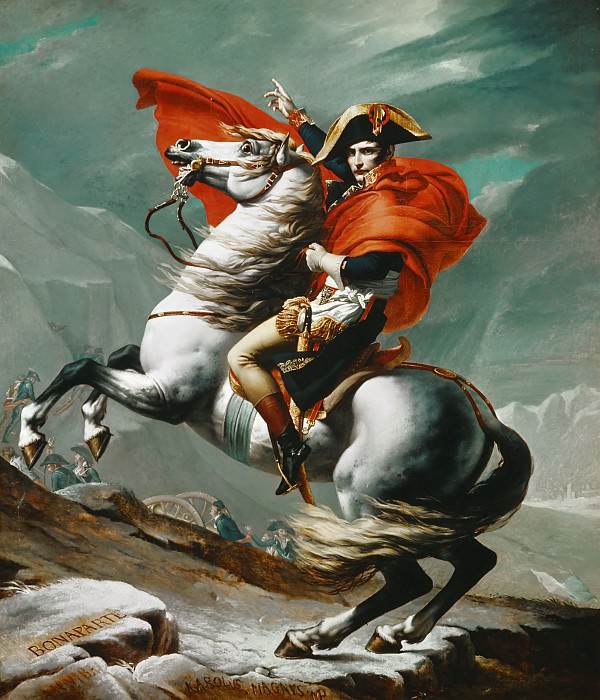Jacques-Louis David – Napoleon Crossing the Saint Bernhard Pass Château de Versailles
Château de Versailles – Jacques-Louis David -- Napoleon Crossing the Saint Bernhard Pass
Edit attribution
Download full size: 2484×2900 px (1,7 Mb)
Back to album: Château de Versailles
David was the founder of French neoclassicism, artistically reinterpreting the standards of classicism and updating them to fit the era. A fervent revolutionary, a supporter of the French Revolution, devoted to Napoleon and believed that he was able to give the world what it needed. "Napoleon at the Pass of St. Bernard" is a staged picture entirely. It is not painted to convey a historical fact or to remind us of how things were; it is designed to magnify Napoleon even more, to give his image a brilliance.
Description of Jacques Louis David’s painting Napoleon on the Pass of Saint Bernard
David was the founder of French neoclassicism, artistically reinterpreting the standards of classicism and updating them to fit the era. A fervent revolutionary, a supporter of the French Revolution, devoted to Napoleon and believed that he was able to give the world what it needed.
"Napoleon at the Pass of St. Bernard" is a staged picture entirely. It is not painted to convey a historical fact or to remind us of how things were; it is designed to magnify Napoleon even more, to give his image a brilliance. The horse is on the reins. The cloak flutters in the wind.
With a regal gesture Napoleon points forward to where his army is to come. Under the hooves of the horse, on the stones, which are no longer a pedestal, are embossed the names - "Hannibal," "Charlemagne" and "Napoleon" - of the great generals who were on this road.
The solemnity and pathos of the painting is due to its purpose. It must be so because it must show Napoleon as a formidable giant, a conqueror before whom kings and countries bowed.
In fact, it was a little different. Napoleon was conquering Italy, that’s right. He was getting there precisely through the Saint Bernard Pass, because he was least expected from there. It never occurred to anyone that he would lead his troops over the passes. But there was no solemnity in it - on the contrary. The army was sinking in the snow. Cannons taken off their wheels were pulled by men on sleds - no cattle could withstand this kind of weather. Many soldiers died of the cold.
Napoleon himself once almost died - the mule stumbled on a steep slope and the commander almost flew into an abyss. It was a great campaign, and David’s painting shows its inner essence, hiding behind the theatricality of the backdrops, behind the fury of the clouds, how much blood and frostbitten men Napoleon left on that pass.
Кому понравилось
Пожалуйста, подождите
На эту операцию может потребоваться несколько секунд.
Информация появится в новом окне,
если открытие новых окон не запрещено в настройках вашего браузера.
You need to login
Для работы с коллекциями – пожалуйста, войдите в аккаунт (open in new window).


















You cannot comment Why?
In the background, tiny figures of soldiers and artillery wagons navigate the treacherous slopes, highlighting Napoleons leadership and the vastness of his campaign. The rugged texture of the rocks in the foreground, inscribed with the names BONAPARTE and KAROLUS MAGNUS (referencing Charlemagne, implying Napoleon as his successor), further solidifies the historical and epic narrative.
The subtexts of this painting are manifold. It is a powerful piece of propaganda, glorifying Napoleon and portraying him as a courageous, divinely-ordained leader. The dramatic pose and the elements of nature create an image of heroic dominance over both man and the environment. The juxtaposition with Charlemagne suggests Napoleons ambition to rebuild a great empire. The painting emphasizes themes of leadership, ambition, conquest, and destiny, presenting Napoleon not just as a military commander but as a figure of monumental historical significance. The idealized portrayal minimizes the actual difficulties faced by the troops and elevates Napoleon to an almost mythical status.